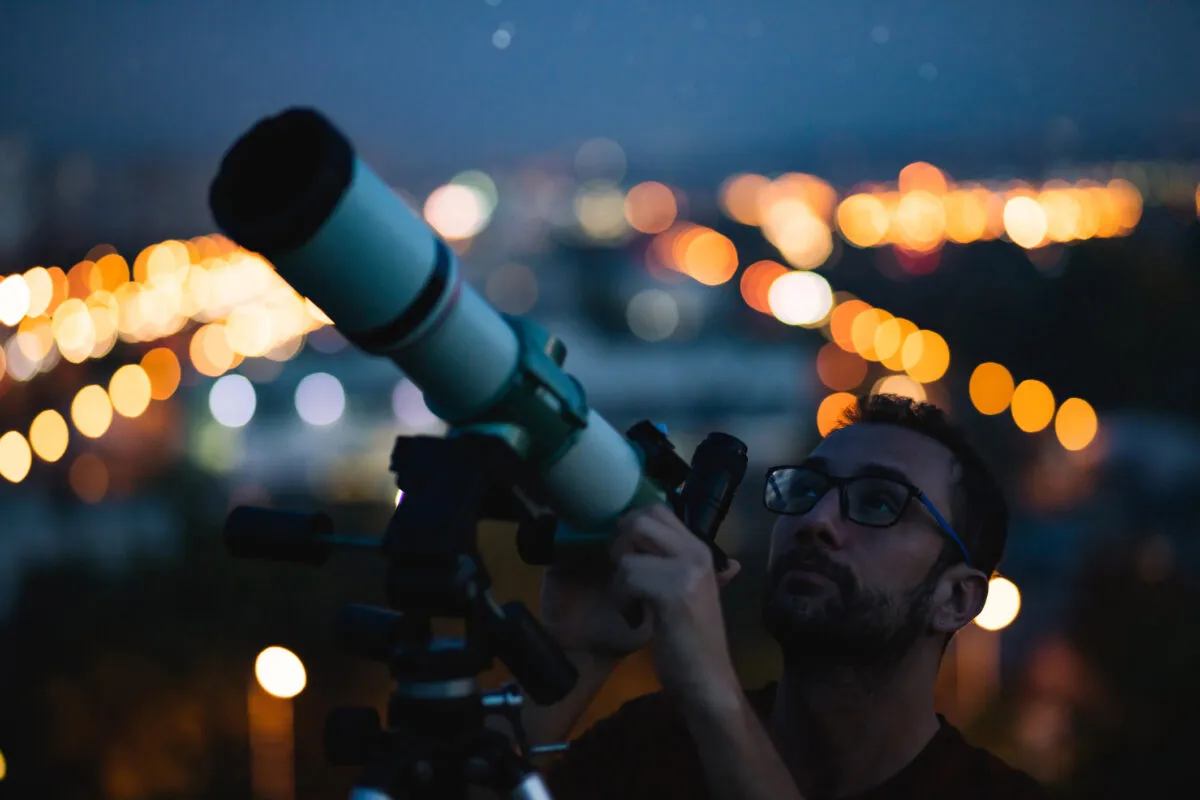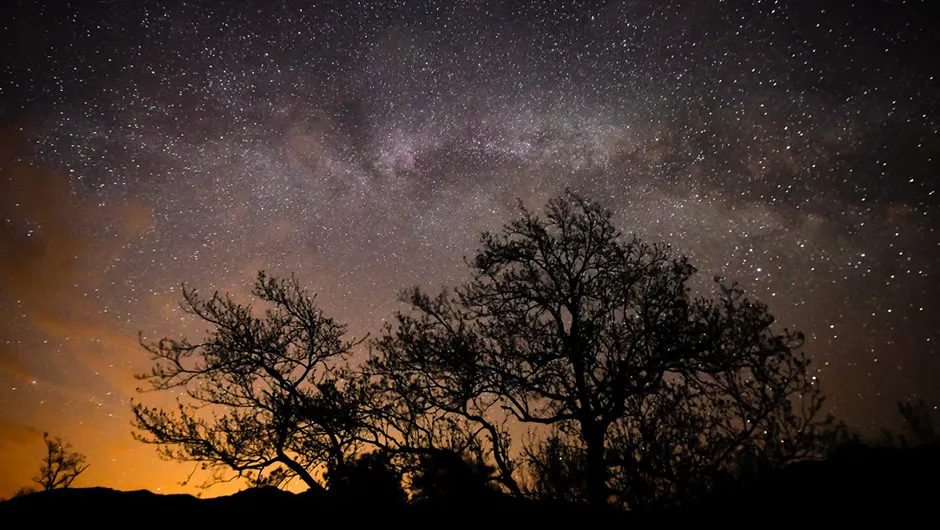They say that home is where the heart is, but is your home where the lights shine?
Electric lighting has changed the way we live and lighting technology has advanced to the point where we can now hold the power of thousands of candles in the palm of our hands.
Artificial light at night (dubbed ‘ALAN’), which causes light pollution, has created its own empire in little over a century, and very few places are left on the globe that have escaped its growing, glowing campaign.

Between 2012 and 2022, light pollution increased globally at a rate of 7–10% each year.
The situation is so dire that many places are now working to protect their night skies.
Due to the low cost of LEDs, lights have crept into places once safe in the shadows.
Daffodil bulbs are being replaced by the glowing LED bulbs of decorative lights in our flowerbeds, from which only light blooms upwards.
From rooftops and rafters hang 1,000-lumen floodlights, the silent enemy of backyard astronomers.
They wait until you’ve assembled your telescope and tripod with frozen fingers and battled to align with your target before revealing themselves, destroying your night vision and wrecking your stargazing plans.

What causes light pollution and why it's an issue
When it comes to light pollution, every bulb counts. We all know how frustrating an ill-placed streetlight can be when it comes to our own personal experiences of trying to stargaze from home.
Light pollution from those individual bulbs accumulates, creating a much bigger issue that impacts us all.
This dome of light covers our towns and cities as the wasted light from millions of unshielded bulbs shines upwards.
It’s bad news for astronomers, both amateur and professional.
A Royal Astronomical Society study recently found that two-thirds of the world’s largest professional observatories are impacted by light pollution and no longer have natural levels of darkness.
If we can’t protect the workplaces of our professional astronomers, what hope have us amateurs in our back gardens and urban parks got?

Light pollution vs the natural world
It’s not only astronomers affected.
Light pollution is increasingly recognised as a major impactor on human health.
As a disruptor to our circadian rhythm, it has been linked to increases in insomnia, diabetes and cancers.
Medical studies have found those of us living in more light-polluted areas are more at risk of developing mental health issues, and it’s even been shown to impact fertility levels.
It all links back to how our brains are hard-wired to respond to natural light cycles.

From the ‘birds and the bees’ to the literal birds and bees, light pollution spells disaster for wildlife.
Light pollution is responsible for the death of between 300 million and one billion birds in the US every single year.
We know that lots of bird species migrate at night, using natural cues in the night sky to find their way.
But human-created ALAN is drawing them off course.
They become lost, disorientated and exhausted, leaving them vulnerable to predators, exhaustion and flying into brightly lit buildings.
We have lost 60% of our winged insects in the UK in the last 20 years, and light pollution is understood to be a major driver of this loss.
We are only beginning to uncover the true impacts on our ecosystems of our addiction to light.

Light pollution solutions
But we do have the solution to light pollution. It’s you. Every single one of us could have an immensely positive impact on light pollution by giving more consideration to how we light our homes.
The golden rule of dark-sky-friendly lighting is to only light what you need to, when you need to.
Does the driveway need to be lit all night? Is your shop’s advertising sign visible without being lit up?
Can you make do without the fairy lights in the garden?
Every bulb must have a purpose – and a pretty aesthetic is not a purpose, unless you count being pretty deadly to wildlife.
If you don’t need the light on, switch it off. One flick of a switch and the problem is solved.

Solving light pollution 6 top tips
Stop light leaking
When lighting is essential, it needs to be fully shielded on the top and sides to prevent light from leaking out into the environment.
It should also be directed straight down. It doesn’t matter how energy-efficient a bulb is if it’s sending light needlessly upwards.
Reduce powerful lighting
Thinking more carefully about lighting can also make it fulfil its purpose better.
Overpowered lights shining into your eyes often make it more difficult to see.
Bright lights create darkness around them. The glare dazzles you, making it harder to see into the shadows.
Reducing powerful lighting creates more subtlety of shadow, making hazards clearer and so reduces accidents

Use timers to control lighting
Timing really is everything. Banish the dusk-til-dawn sensors from your lawns and install motion sensors or timers.
For example, fit a motion sensor at the bottom of your driveway so your lights are triggered as you pull up to your home, but then turn off when you’re safely inside.
Motion sensors are also great for security, alerting you to the fact that someone is around your property.
There are many options for timers now, from traditional clock timers to cutting-edge smart light technology which you can control from an app on your phone.
These are a great option as they can be preprogrammed to illuminate at a time of your choosing, or you can turn them on and off at will.
Reducing the amount of time your lights are on also helps reduce the amount of electricity you’re using, keeping down both carbon emissions and your energy bill.
Use dimmer lights
It’s better to have more light fittings at a lower intensity of brightness than one powerfully bright floodlight trying to wash over everything.
This way you can have more control over what is lit and when.

Think warm
Crucially, warmer colour temperatures are key when it comes to dark-sky lighting.
Harsh, cool-white lights, which emit a lot of blue light, are damaging to human health, our wildlife and our night sky.
When it comes to colour temperature, stick to warmer-coloured bulbs.
The best temperature is 2,700 Kelvin or lower, which glows towards the redder end of the spectrum.
The warmer the colour temperature, the better it is for humans and wildlife.
It also gives a more aesthetically pleasing, cosy glow, instead of that of a dentist’s waiting room.
Get the community involved
If you really want to fight light pollution, involve the rest of your community. Most people are unaware of light pollution.
Having a friendly conversation with a neighbour or writing to your local councillor or MP about the benefits and savings can be the catalyst for major changes locally.
Sometimes it’s as simple as setting up a telescope in a local park to show your community a view of the Moon like never before, so they can better appreciate what it is they’re losing.
You can also help monitor the impact of light pollution on our night skies via citizen science campaigns, such as the CPRE’s annual star count or the Globe at Night project.
Dark-sky-friendly lighting saves you money, the climate from crisis, our ecosystems from collapse, your neighbours from health issues, and the starry sky all at once.
Not bad for a night’s work, eh?
Stargazing in a light-polluted area

Light pollution has made amateur astronomy and casual stargazing a challenge.
If you aren’t lucky enough to live in an area with dark skies or can’t travel to one, there are some things you can do to improve your viewing experience.
Find your nearest area of relative darkness – this could be in a suburban park, sports field or even churchyard.
These tend not to have their own lighting, so are relatively darker than the surrounding streets.
View as late into the evening as possible, as many councils dim streetlights from 11pm.
Most residents will have gone to bed then, hopefully switching lights off behind them.
There will be fewer car headlights on the road too.
Light-pollution filters can be fitted to your telescope’s eyepiece, which filter out specific wavelengths of light.
However, if you live on an LED-lit street, LEDs are notoriously difficult to filter out as they cover a broad spectrum of wavelengths.
Some light-pollution filters are now available specifically for filtering out LED lamps, like the IDAS LPS-D3, which could help improve your views.
Find out more in our guide on how to stargaze from a light-polluted city.
Do you have any thoughts on light pollution, or ways in which you've managed to solve it in your area? Let us know by emailing contactus@skyatnightmagazine.com
This article appeared in the April 2024 issue of BBC Sky at Night Magazine